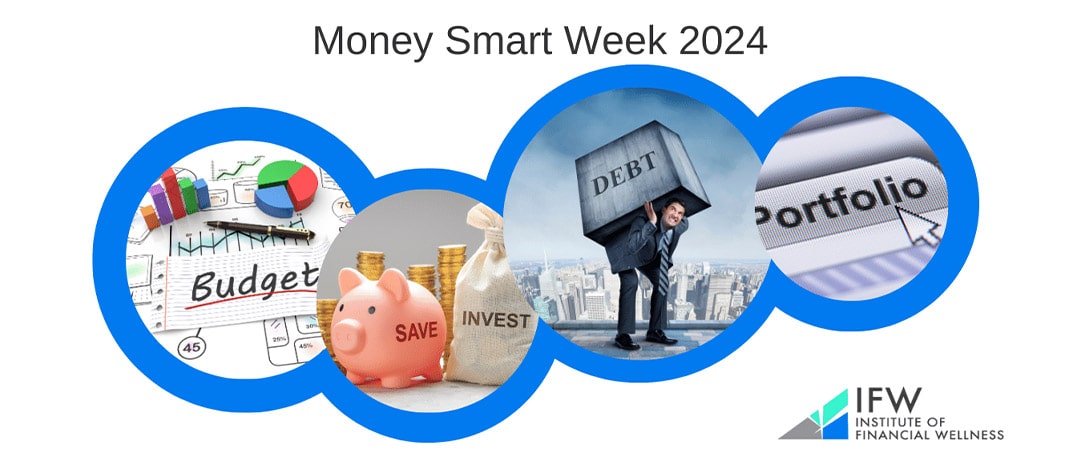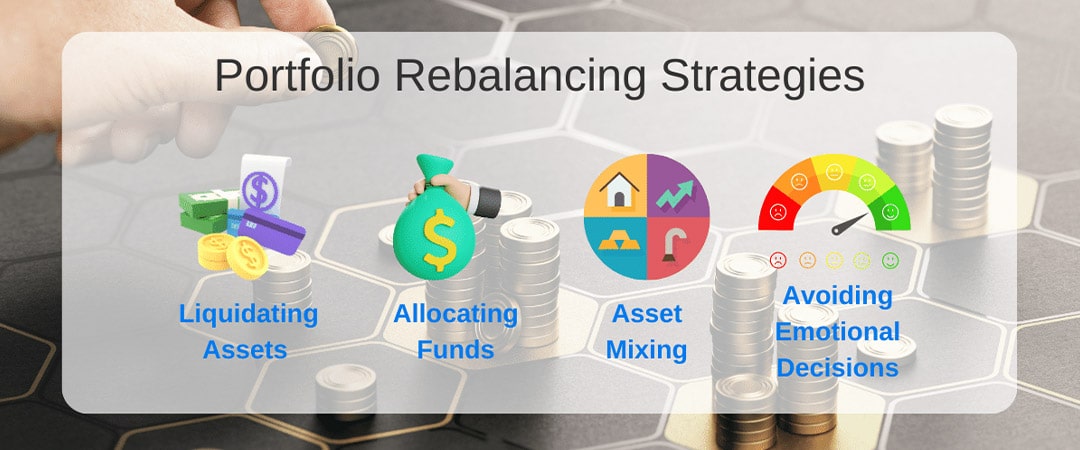“Retirement is when you stop living at work and start working at living.” – Author Unknown
Navigating the ‘rebalance portfolio’ process starts here. Volatile markets can derail your investment goals—if you let them. Are you ready to get empowered with the right times, strategies, and factors to consider, ensuring you retain control over your investment journey, no matter the market trends? Money Smart Week is the perfect time of the year to dive in to align your portfolio with your risk preferences and secure the financial destination you’re aiming for.
And part of Money Smart Week includes future financial preparations. Learn your retirement score today with the Institute of Financial Wellness. Let’s dive right in!
Key Takeaways
- Portfolio rebalancing is a process to align investments with an investor’s long-term goals and risk tolerance, which helps manage risk and prevent portfolio drift due to market shifts.
- Different strategies for rebalancing include time-based, threshold-based, and hybrid approaches, which must be chosen based on individual investment goals, risk tolerance, and market conditions.
- Financial professionals offer expert guidance in rebalancing portfolios, ongoing monitoring, and personalized strategies, helping investors navigate through the complexities of maintaining their desired asset allocation.
Empowering Communities: Insights into Money Smart Week 2024
Money Smart Week 2024 is an event that unites communities, financial institutions, government agencies, educational institutions, and nonprofits with the aim of promoting financial literacy and empowerment. It’s an annual initiative designed to equip individuals with the tools and knowledge necessary for making informed financial decisions, effectively managing their finances, and achieving their financial goals.
Throughout the week-long event, participants can engage in a variety of activities, workshops, seminars and access resources centered around different aspects of personal finance. These include financial education workshops held in local libraries, community centers, and financial institutions. These workshops cover topics such as budgeting, saving, investing, managing debt, understanding credit scores, rebalancing portfolios, and retirement planning. Led by financial experts and educators, these workshops offer valuable insights and practical tips.

Moreover, Money Smart Week offers online webinars and resources, making financial education accessible to a broader audience. These virtual sessions cover topics similar to those in the in-person workshops and provide an opportunity for individuals to learn from experts regardless of their location.
In addition to workshops and webinars, many communities organize financial wellness fairs during Money Smart Week. These fairs provide attendees with access to information from various financial institutions, nonprofits, and government agencies. They often feature booths, demonstrations, and interactive activities to engage participants and enhance their financial literacy.
Money Smart Week also emphasizes the importance of financial education for young people. Hence, various events are tailored to youth, offering age-appropriate workshops and activities to teach them about money management, saving, and responsible financial behavior, as well as portfolio management and rebalancing.
The Importance of Portfolio Rebalancing
Imagine piloting a vessel with the breeze shaping your path, requiring constant adjustment of the sails to maintain your intended direction. In much the same way, portfolio rebalancing is an essential mechanism within investment management. It ensures that one’s investments are consistently aligned with one’s long-term objectives—the equivalent of fine-tuning your sailing approach to navigate accurately.
Rebalancing keeps a portfolio structured so it is not excessively swayed by ephemeral market fluctuations but instead mirrors an investor’s appetite for risk and overarching investment strategy. Should rebalancing be neglected, external market forces could warp the risk level embedded in the portfolio, causing it to stray from its owner’s predetermined risk profile and desired outcomes [1].
Risk Management
If market fluctuations cause some investments to perform better than others, disproportionate emphasis on these high-performing assets might inadvertently elevate your portfolio’s overall risk and volatility. This can result in a deviation from an investor’s initial risk tolerance level. Rebalancing is vital for readjusting the investment balance within the portfolio to align with one’s preferred level of exposure.
Investors engage in regular rebalancing to keep their portfolios attuned to their desired balance between security and opportunity based on individual experience and acceptance of financial risks. To preserve this equilibrium, it is essential for investors to periodically adjust their asset allocations by rebalancing their portfolios whenever necessary.
We advise you to get help from financial advisors like those at The Institute of Financial Wellness to learn about the best way to rebalance your portfolio.
Maintaining Target Asset Allocation

Investing starts with setting a target allocation for each type of asset class. Over time, varying performances across different securities and asset classes can shift this initial balance, changing the risk profile of your portfolio. Rebalancing is used to realign the portfolio back in line with its planned target allocation by addressing these deviations caused by market fluctuations.
To avoid an overconcentration in certain types of assets, such as stock holdings, which may result from dynamic market conditions, rebalancing employs specific strategies. Let’s take a look.
- Liquidating assets that have gained value
- Allocating funds to those that haven’t performed as well
- Maintaining the desired mix of assets
- Avoiding decisions based on emotion when it comes to investing choices.
Enhancing Portfolio Performance

Rebalancing encompasses not solely the mitigation of risk but also aims to improve the performance of a portfolio. By maintaining rebalanced assets, an investor can:
- Ensure adherence to established levels of risk and expected returns
- Avoid becoming excessively invested in any particular asset class due to its outsized growth
- Enhance the potential for greater long-term financial yields.
By employing a disciplined approach to rebalancing, investors are poised to leverage market swings—purchasing assets when their value is low and selling them when they have appreciated. This strategy not only boosts the overall performance of their portfolios but also offers protection from losses during times when markets underperform, often leading to superior outcomes compared with portfolios that lack such balance.
Rebalancing Strategies and Techniques

The process of rebalancing does not adhere to a uniform method. There is a spectrum of strategies for rebalancing your portfolio, which encompass those predicated on specific time intervals, others dictated by particular thresholds of change in the portfolio’s value, and hybrid methods that combine aspects from both. Each strategy has distinctive advantages and factors to consider.
When engaging in tolerance-based rebalancing, one establishes desired proportions for each asset class within their portfolio, along with an acceptable range of variation. The aim is to return the portfolio to these initial targets once any asset class’s weight strays outside its designated band. This necessitates periodic examination of the portfolio but doesn’t always translate into making transactions at every check-in.
Time-Based Rebalancing
Calendar rebalancing entails periodic examination and adjustment of one’s portfolio according to predetermined time frames, such as monthly or quarterly. This method is advantageous for its straightforward nature, structured procedure, and lack of constant daily oversight—qualities that make it particularly suitable for investors who manage their own investments.
Engaging in calendar rebalancing at a minimum once every year helps avoid the phenomenon known as portfolio drift. This ensures that the portfolio remains aligned with an investor’s preferred level of risk tolerance and investment preferences.
Threshold-Based Rebalancing
Conversely, threshold-based rebalancing is executed when the weight of an asset class in a portfolio deviates beyond its preset tolerance level. A frequently adopted guideline for such thresholds is to initiate reallocation once an individual asset’s contribution causes a variation exceeding 5% [2]. Implementing exact benchmarks for rebalancing serves to eliminate emotional biases from investment choices by relying on previously established standards that improve risk management.
Setting broader tolerance ranges for rebalancing can result in less frequent and more modest adjustments, affording investors the opportunity to capitalize on positive market trends within the aggregate bond index despite downturns in markets.
Hybrid Rebalancing
The hybrid rebalancing strategy blends elements of both temporal and threshold-based methods to preserve designated asset allocations within an investment scheme. This approach is facilitated by instruments such as target-date funds and robo-advisors, which autonomously modify the portfolio in alignment with an approaching retirement milestone to sustain the preferred mix of assets.
To assist this methodology, rebalancing software provides functionalities that include automatic portfolio adjustments, tools for modeling asset allocation, and strategies for efficient tax management.
Factors to Consider When Rebalancing
Rebalancing strategies are crucial for maintaining an investment portfolio, but they must be considered alongside other significant elements, such as:
- The objectives of the investment
- The investor’s capacity to tolerate risk
- Costs associated with executing transactions
- Consequences on taxation
- Current conditions in the financial markets
Each one is integral to successfully carrying out a rebalancing process.
Implementing hybrid rebalancing strategies that combine time-based and threshold-based methods can introduce complexity. This arises from balancing predetermined time periods with explicit percentage criteria that trigger reallocation.
Investment Goals and Risk Tolerance
The process of rebalancing is initiated by establishing one’s financial objectives, time horizon, and capacity for risk-taking. These components are crucial in creating a diversified collection of financial assets that align with the individual’s unique criteria. The congruence between investment aims and tolerance for risk during the act of rebalancing plays a pivotal role because, as asset values fluctuate over time, they can alter the proportional distribution within a portfolio—thus changing its inherent level of risk.
Rebalancing involves periodically adjusting the composition of assets in an investor’s portfolio to ensure it continues to reflect their desired mix appropriate to their investment targets and appetite for risk. This strategy aims at both reducing volatility within the portfolio through effective management of risks and enhancing its overall value to meet specified investment goals.
Transaction Costs and Tax Implications
Investors should be mindful that rebalancing carries associated costs. These include transaction expenses like brokerage fees, bid-ask spreads, and possibly market impact costs if the trades are large. When considering whether to trade or not, investors need to balance these trading costs against the advantages of sticking with their predetermined target asset allocation. Small deviations in the asset mix might not warrant incurring such expenses [3].
When rebalancing an investment portfolio, investors should consider the tax implications of realized gains. Long-term capital gains receive better tax treatment at lower rates than short-term gains, which are taxed as regular income.
Financial advisors can help you with your investment portfolio, don’t hesitate to get in contact with experts that can help you create more wealth!
Market Conditions and Volatility

Market fluctuations are a pivotal factor in determining when to rebalance a portfolio. Significant shifts resulting from market volatility can lead to deviations that require adjustments back toward the target asset allocation. Market dynamics, exemplified by rising or falling stock prices, might prompt the need for rebalancing in order to preserve an investor’s preferred risk profile.
In periods of economic instability, investors often engage in portfolio rebalancing to reduce their exposure to high-risk assets and augment their investments in more secure assets. Implementing a blended strategy for rebalancing allows investors to respond effectively to changing market conditions while also adhering steadfastly to disciplined portfolio management.
Rebalancing in Different Life Stages
Portfolio rebalancing is an ongoing process that demands vigilance across various stages of life, encompassing the investing journeys of individuals who are just starting out, those in the midst of their careers, and persons nearing retirement. Significant milestones or shifts in one’s life may incite investors to reevaluate their portfolio composition and engage in rebalancing to ensure it corresponds with evolving realities.
For example, encountering a health crisis might catalyze a profound reassessment of fiscal goals. Such events underscore the necessity for conducting portfolio rebalancing to adequately mirror updated needs and preferences rooted in these new developments.
Young Investors
Investors who are new to the realm of investment can significantly gain from the practice of rebalancing, which helps maintain a portfolio that reflects their desired level of risk and their long-term goals for investing. These investors often have a higher tolerance for risk and might orient their portfolios towards growth by allocating a substantial portion to stocks—particularly emerging market stocks—and will need regular portfolio adjustments through rebalancing in order to keep up with the intended level of risk.
Ultimately, young investors can mitigate long-term risks while preserving an optimal degree of diversification in their portfolios through frequent rebalancing.
Mid-Career Investors
Investors in their mid-career phase should emphasize asset allocation, carefully weighing growth prospects against the need to minimize risk. Implementing rebalancing strategies such as ‘While you’re at it’, which adjusts allocations when adding or withdrawing funds, and ‘Sweat the Biggest Stuff’, which concentrates on major large-cap holdings, can help control portfolio drift and preserve an equitable distribution of assets.
The process of rebalancing usually requires modifications throughout various financial accounts to re-establish the desired mixture within a portfolio. Occasions like preparing taxes or conducting year-end tax-loss harvesting could serve as convenient moments for investors to realign their portfolios.
Approaching Retirement
When approaching retirement, investors should adjust their portfolios to concentrate on generating income and accommodate a more conservative risk tolerance than what was suitable in their earlier years. Rebalancing often involves decreasing the proportion of equity by modifying the asset allocation balance towards bonds.
In order to safeguard capital during retirement, it is prudent for retirees to create a safety net by liquidating assets that have appreciated substantially and channeling those funds into assets that provide steady income streams. By employing a bucket strategy, retirees can keep cash reserves on hand, which circumvents the necessity of selling assets at an inopportune time when market values are low, thereby helping to maintain the overall value of their portfolio.
The Role of Financial Professionals in Portfolio Rebalancing

Navigating the intricacies of portfolio rebalancing can be overwhelming for individual investors, which is why financial professionals are critical. These experts provide essential services, including expert advice, continuous supervision, and tailored approaches to help rebalancing.
Financial advisors assist investors in adhering to their initial asset allocation plans, avoiding typical mistakes, and making adjustments to portfolios as necessary due to changes in an investor’s life circumstances. Their expertise proves invaluable throughout this complex endeavor. Check out The Institute of Financial Wellness and what we can offer you to help you rebalance your portfolio.
Expert Guidance
Expert assistance can aid investors in several critical areas:
- Preserving their intended asset allocation approach and desired risk profile through recommended changes for portfolio rebalancing
- Steering clear of typical mistakes like making choices based on emotions or pursuing the past performance of investments during portfolio readjustment
- Modifying the asset distribution within a portfolio to align with shifts in an investor’s life situation or revisions to their investment strategy
When it comes to navigating stock investments, including international stocks, professional insight is invaluable for helping investors make educated decisions that are aligned with achieving their financial aspirations.
Specialists in investment and advisors have the necessary knowledge to accurately evaluate both the performance of a portfolio and its associated risks. They ensure adherence to legal standards while offering impartial guidance.
Ongoing Monitoring
Financial experts continuously supervise investment portfolios to make sure they consistently match the goals and risk appetite of the investor. Their routine assessments of investment strategies include:
- Verifying that the portfolio’s asset mix continues to align with both the investor’s objectives and their willingness to accept risk
- Pinpointing any required modifications or portfolio rebalancing acts
- Evaluating how each individual investment is performing
- Keeping abreast of market evolutions and fluctuations
Open dialogue and consistent reports from financial advisors are essential for preserving clarity while helping investors make educated choices regarding their investments.
Investment management tools such as robo-advisors automatically orchestrate an investor’s portfolio in line with defined targets and level of accepted risk, handling adjustments when necessary. These can encompass instruments like mutual funds among other options.
Personalized Strategies
Each investor has distinct financial goals and necessities, which necessitates a customized approach to their investment portfolio. Financial advisors can craft bespoke rebalancing strategies that take into account an individual’s age, willingness to accept risk, and the period over which they plan to invest. Advisors may provide tailor-made services, including tax-aware approaches and asset allocation management in alignment with each client’s unique requirements.
Such personalized strategies for portfolio rebalancing are designed to be adaptable during significant life changes, ensuring that investors’ portfolios continue to reflect their evolving situations throughout different stages of life.
Optimizing Portfolio Rebalancing with the Institute of Financial Wellness: Expert Guidance for Fiscal Prosperity
For professional advice on portfolio rebalancing, look no further than The Institute of Financial Wellness. Our extensive multi-media network offers an array of financial educational materials, resources, and services that stand out as particularly informative and impartial in the industry. The institution’s offerings are crafted to instill clarity and confidence in individuals seeking to make knowledgeable financial choices.
The institute excels at devising and executing personalized strategies designed to fit each person’s distinct portfolio rebalancing requirements. We are committed to providing continual assistance and direction aimed at fostering optimal fiscal prosperity throughout various life phases and helping you trace your retirement roadmap.
Full Summary
Rebalancing your investment portfolio is essential for aligning your investments with long-term financial goals and acceptable levels of risk. There are several strategies for rebalancing that offer different advantages and considerations, taking into account factors like transaction costs, tax implications, market conditions, as well as individual investment objectives and risk profiles. Life stages can influence the approach to rebalancing a portfolio. Thus, seeking advice from financial experts might be beneficial. The Institute of Financial Wellness offers a thorough education in finance along with resources and services that assist individuals in making educated financial decisions to fulfill their investment aspirations.
Frequently Asked Questions
What is the best way to rebalance your portfolio?
In order to maintain the intended balance within your portfolio, you should divest from investments that have outperformed and invest in those that have underperformed. When introducing new capital, it’s crucial to allocate these funds deliberately so as to preserve the desired asset distribution. This process involves evaluating the existing proportions of assets in your portfolio against your goal allocation and making necessary strategic changes accordingly.
How often should you rebalance a portfolio?
It is widely advised that to manage risk effectively, you ought to rebalance your portfolio once a year.
If your portfolio has a good mix of investments, considering less frequent rebalancing might also prove advantageous.
What does rebalancing of portfolio mean?
Adjusting the proportions of various asset classes in your portfolio to preserve the desired mix of investments and level of risk is known as rebalancing your portfolio. This systematic approach ensures that your investment strategy stays in sync with your financial objectives and tolerance for risk.
What is the 5/25 rule for rebalancing?
The 5/25 rule for rebalancing indicates that you ought to adjust your portfolio if the proportion of any asset deviates from its intended initial allocation by an absolute margin of 5% or a relative one of 25%, opting for whichever threshold is lower. This involves making changes when there’s significant drift in an asset class or category compared to its originally planned target percentage.
What are the main rebalancing strategies?
Primary strategies for rebalancing a portfolio encompass those based on time intervals, threshold levels, and a combination of the two approaches.
In a time-based strategy, adjustments to the portfolio are made at regular predetermined times. A threshold-based strategy triggers rebalancing when the weight of any asset class deviates beyond its established tolerance limit. The hybrid strategy merges elements from both time and threshold-based methodologies for rebalancing purposes.




